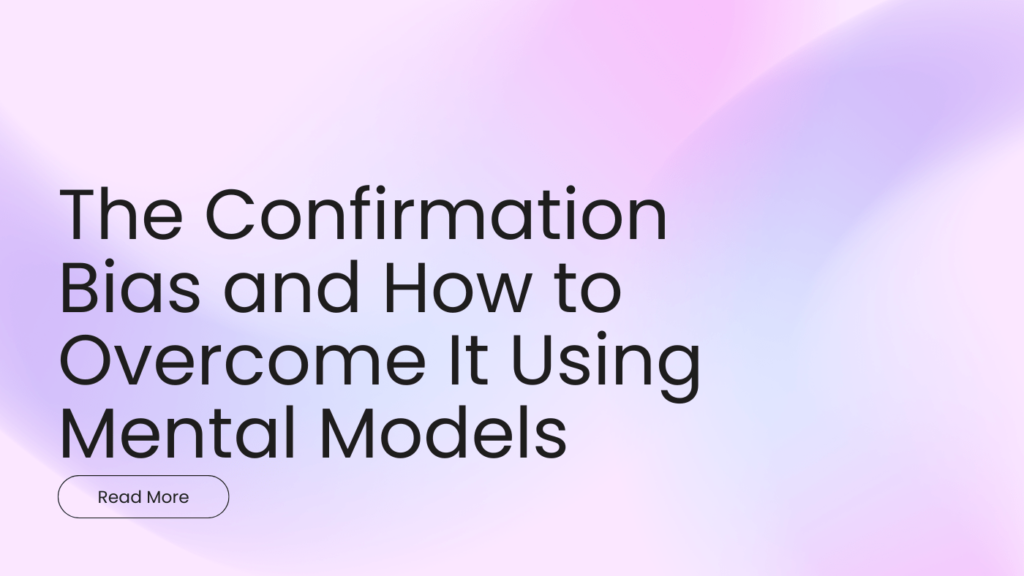The Confirmation Bias and How to Overcome It Using Mental Models
We all want to be right. It’s human nature. But that desire can lead us down a dangerous path: the path of the confirmation bias. This insidious cognitive bias can cloud our judgment, leading to poor decisions and hindering our ability to learn and grow. This article will explore what confirmation bias is, how it affects us, and, most importantly, how we can use mental models to overcome biases and improve our better decision making.
What is Confirmation Bias?
Confirmation bias, at its core, is the tendency to favor information that confirms our existing beliefs or hypotheses. We seek out, interpret, and remember information in a way that supports what we already think is true. Conversely, we tend to ignore, dismiss, or downplay information that contradicts our beliefs. This can happen consciously or unconsciously, making it a particularly tricky bias to identify and combat.
As Raymond Nickerson succinctly puts it in his seminal work on the subject, “Confirmation bias…is ubiquitous in human reasoning and decision-making.” (Nickerson, R. S. (1998). Confirmation bias: A ubiquitous phenomenon in many guises. *Review of General Psychology, 2*(2), 175–220.)
Think about it: Have you ever been in an argument where you actively searched online for articles that supported your point of view, while conveniently overlooking those that challenged it? That’s confirmation bias in action.
Examples of Confirmation Bias in Everyday Life
- Politics: People tend to follow news sources and social media accounts that align with their political views, reinforcing their existing beliefs and creating echo chambers.
- Investing: Investors might hold onto losing stocks longer than they should, selectively focusing on positive news about the company while ignoring warning signs.
- Medical Diagnosis: Doctors may prematurely settle on a diagnosis and then seek only information that confirms it, potentially overlooking other possibilities.
- Relationships: We might focus on the positive aspects of our relationships and downplay any red flags, even if they are glaringly obvious to others.
The Dangers of Unchecked Confirmation Bias
Allowing confirmation bias to run rampant can have serious consequences:
- Poor Decision Making: Biased information processing leads to flawed judgments and suboptimal choices.
- Missed Opportunities: By dismissing contradictory information, we might miss out on valuable insights and innovative ideas.
- Polarization and Conflict: When everyone is selectively confirming their own beliefs, it becomes difficult to find common ground and resolve disagreements.
- Stunted Growth: If we only seek information that validates our existing beliefs, we limit our ability to learn, adapt, and evolve.
How to Overcome Confirmation Bias Using Mental Models
Fortunately, there are strategies we can employ to mitigate the effects of confirmation bias. One of the most effective tools is the use of mental models.
Mental models are simplified representations of how something works. They are frameworks that help us understand complex systems, make predictions, and solve problems. By consciously applying different mental models, we can challenge our assumptions, broaden our perspectives, and make more informed decisions.
Here are a few mental models that are particularly helpful in overcoming biases and improving better decision making:
1. Inversion
Instead of focusing on what you want to prove, try to disprove it. Ask yourself, “What evidence would contradict my belief?” This forces you to actively seek out disconfirming information, which is the direct opposite of what confirmation bias encourages. Charlie Munger, Warren Buffett’s longtime business partner, is a strong proponent of inversion, stating that it can “help you identify and avoid stupid mistakes.”
Example: If you believe a particular marketing campaign is going to be successful, use inversion to ask: “What factors could cause this campaign to fail?” This could lead you to identify potential weaknesses and make necessary adjustments.
2. Occam’s Razor
Occam’s Razor, also known as the principle of parsimony, suggests that the simplest explanation is usually the best. When faced with multiple explanations for a phenomenon, choose the one that requires the fewest assumptions. This can help you avoid overcomplicating things and falling prey to convoluted justifications for your existing beliefs.
Example: If your website traffic suddenly drops, don’t immediately jump to a complex explanation involving algorithm updates or competitor attacks. Consider simpler explanations, such as a server outage or a broken link.
3. First Principles Thinking
First principles thinking involves breaking down a problem into its most fundamental truths and then reasoning up from there. This allows you to question assumptions and build your understanding from the ground up, rather than relying on pre-existing beliefs. As Elon Musk famously uses, it forces you to reconsider deeply held assumptions.
Example: If you believe a particular task is impossible, break it down into its core components. Can each component be achieved? If so, the task is likely possible, even if it initially seemed insurmountable.
4. Circle of Competence
Understanding your circle of competence means knowing the boundaries of your knowledge and expertise. Avoid making decisions outside of this circle, as you are more likely to be influenced by biases and make mistakes. Recognize what you don’t know and seek out expert opinions when necessary.
Example: If you’re not a financial expert, don’t try to pick individual stocks based on gut feeling. Stick to index funds or consult with a qualified financial advisor.
5. Red Teaming
Red Teaming involves deliberately challenging your own ideas and strategies by assigning a team to act as the “enemy” and find flaws in your plan. This can help you identify vulnerabilities and anticipate potential problems before they arise. It’s a proactive approach to uncovering weaknesses you might otherwise overlook.
Example: Before launching a new product, a red team could try to find ways to break the product, identify security vulnerabilities, or exploit weaknesses in the marketing strategy.
Practical Steps to Combat Confirmation Bias
- Acknowledge Your Biases: The first step is recognizing that you are susceptible to confirmation bias. Be aware of your own tendencies and triggers.
- Seek Out Diverse Perspectives: Actively seek out opinions and information that challenge your beliefs. Read articles from different viewpoints, talk to people with opposing opinions, and expose yourself to diverse experiences.
- Ask “Why Am I So Sure?”: When you feel strongly about something, pause and ask yourself why you are so confident. What evidence supports your belief? What evidence contradicts it?
- Be Open to Being Wrong: Embrace the possibility that you might be wrong. Recognize that learning and growth often come from admitting our mistakes.
- Document Your Reasoning: Write down your assumptions, evidence, and reasoning processes. This can help you identify flaws in your thinking and avoid biased interpretations.
Conclusion
Confirmation bias is a powerful cognitive bias that can significantly impair our judgment and decision-making abilities. However, by understanding how it works and actively employing strategies like mental models, we can learn to overcome biases and make more rational, informed choices. Cultivating intellectual humility, seeking diverse perspectives, and constantly questioning our assumptions are crucial steps towards building a more accurate and nuanced understanding of the world. By embracing these practices, we can move beyond the limitations of our own biases and unlock our full potential for better decision making and continuous growth.
References
- Nickerson, R. S. (1998). Confirmation bias: A ubiquitous phenomenon in many guises. *Review of General Psychology, 2*(2), 175–220.
- Kahneman, D. (2011). *Thinking, fast and slow*. Farrar, Straus and Giroux.
- Munger, C. T. (2005). *Poor Charlie’s Almanack: The Wit and Wisdom of Charles T. Munger*. Third Edition. Donning Company Publishers.
“`


